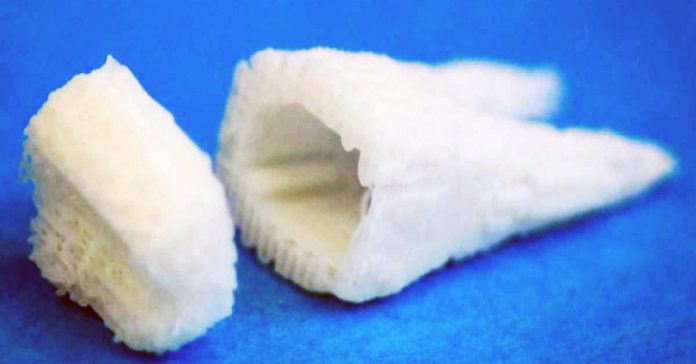If you’re missing teeth at the moment your only recourse is heading to the dentist and getting dental implants. This is a procedure that takes time and healing like most dental procedures but results in very real ceramic teeth.
But what if the teeth could just grow back? That’s what Dr. Jeremy Mao, Professor of Dental Medicine at Columbia University Medical Center, is working on. He has published a study in the Journal of Dental Research saying it’s possible to regrow adult teeth using stem cells and a 3D printed tooth scaffold.
Related Topics (Ads):

In only nine weeks the study showed “The human molar scaffolds showed integration and tissue ingrowth. Researchers also found that the growth factors recruited significantly more endogenous cells and led to greater angiogenesis than did the growth-factor–free control scaffolds.”
What does this mean? In the future you may be able to regrow your adult teeth with the use of stem cells. The University of Colombia has already filed for patents on the process and will likely be pursuing commercial applications as soon as they can get approval from regulatory bodies. So while that takes time, progress is being made.
Until then, the best way to replace missing teeth is by visiting your dentist and getting dental implants. This is not as scary or expensive as it sounds, technology in the dental implant space has come a long way. All dental implants have a ceramic coating, so they look just like your real teeth – or even better! Underneath they are a titanium base that is drilled into your jawbone and fuses there for life. Titanium is a biocompatible metal which means it binds to organic tissue and bone.
From there the dentist will attach a ceramic crown into the base. The rise of 3D printing and other new technologies have made these fit better and last longer than ever before. 3D printers used to be huge machines that took a painstaking amount of time to print even the simplest materials, but 3D printing has now evolved to become not just a household item, but also capable of printing biological material, like skin tissue. Thanks to advancements in 3D printing technology along with computer-aided design (CAD), it has developed a widespread use in modern dentistry. Prosthodontists, the professionals responsible for designing the teeth, are now able to custom make crowns and bridges that are completely unique to each patient, and the design process is incredibly quick thanks to 3D printing. 3D printing had already been in use for prototyping the materials to use in such dental procedures, but thanks to the rapid developments in 3D printing technology, it’s being used for the actual production models that are implanted in the jaw. The 3D printers are able to print not only the ceramics used in crowns and bridges but the titanium posts as well. 3D printing has also created innovative surgical guides made of tough plastics for placing the implants, which greatly minimizes human error. Experiments on monkeys has also been done on the possibility of using CAD and 3D printing to create a custom titanium post that more organically resembles the missing root rather than a threaded, straight or tapered design. The fusing of bone to titanium had proven to be quickened, which ultimately lowers healing times. For example, say a patient needs a dead tooth to be replaced. Before even removing the tooth, dental professionals can scan the tooth and create a 3D image of it in a computer. They can then 3D print a dental implant resembling that tooth and it’s root and has it ready for replacement, which eliminates the need for a second surgery altogether.
Related Topics (Ads):
Why is Now the Best Time for Dental Implants?
Such advancements in the technology of the materials, techniques, and designs have increased the success rate of dental implants dramatically, so much so that dental professionals are recommending them over other more temporary solutions to your missing teeth. Also, these advancements don’t just make dental implant procedures easier for surgeons, it’s easier on you, the patient! Imagine being told that after your surgery, you’ll experience minimal discomfort for a short while, and you’ll only have to wait a couple months for healing. Then you can use your permanent, new teeth for the rest of your life! Compare this to the awkward, discomfort of wearing dentures for the rest of your life. The advancements in dental implant technology have made dental implants such a great choice for people that denture use is on the decline. In a scientific journal, a study showed declined denture use has been on a downward trend since the 1980s, which is when dental implants were first becoming a widespread practice.
Where do I find the most advanced dental implants?
Finding dental implants that put to use the latest technology in dental implant procedures is of utmost importance. You have to know where to look. Start online and look in your area. Find maxillofacial surgeons that boast state of the art equipment and professionals. They will employ the latest in dental implant technology that will make your surgery quick and relatively painless.
Related Topics (Ads):
Citations
https://jada.ada.org/article/S0002-8177(14)64763-2/fulltext
https://www.mayoclinic.org/tests-procedures/dental-implant-surgery/about/pac-20384622
https://www.ncbi.nlm.nih.gov/pmc/articles/PMC5671421/
